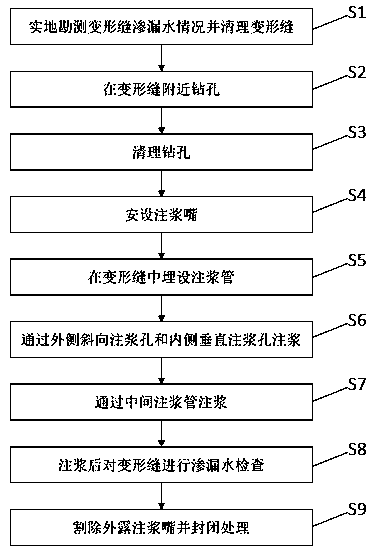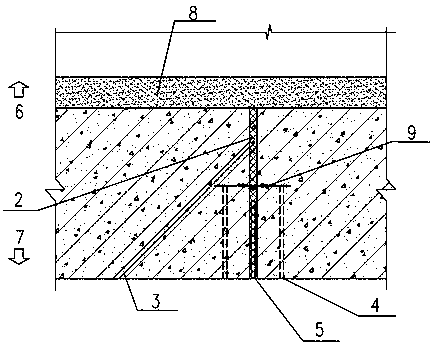Progressive control method of railway open trench tunnel lining deformation joint leakage water
A technology of open-cut tunnels and deformation joints, applied in water conservancy projects, underwater structures, artificial islands, etc., can solve repeated water leakage, cannot completely block leaking water channels, and cannot achieve leaking water channel blocking And other issues
- Summary
- Abstract
- Description
- Claims
- Application Information
AI Technical Summary
Problems solved by technology
Method used
Image
Examples
Embodiment 1
[0071] A newly built railway tunnel has a starting and ending mileage of DK286+250~DK293+550 (excluding DK288+400~DK290+250), and the total length of the section tunnel is 5450 m. The tunnel entrance section of a tender section in front of the railway station has a mileage of DK286+250~DK288+400 and a length of 2150 m. It is designed to be constructed by open-cut method. Surface water such as a tributary of a river is distributed in the tunnel area. Although the river has stopped flowing, there is still a small amount of water locally, with a water depth of 0.5-1.5 m. It is corrosive to concrete structures with chloride salts, and the environmental action level is L1. The groundwater in the tunnel area is mainly Quaternary pore water and bedrock fissure water. During the survey period, the groundwater level was buried at a depth of 0.9-3.5 m (elevation 4.05-12.9 m). The groundwater level was relatively high, and it infiltrated along the joints and fissures, forming band-shaped...
PUM
 Login to View More
Login to View More Abstract
Description
Claims
Application Information
 Login to View More
Login to View More - R&D
- Intellectual Property
- Life Sciences
- Materials
- Tech Scout
- Unparalleled Data Quality
- Higher Quality Content
- 60% Fewer Hallucinations
Browse by: Latest US Patents, China's latest patents, Technical Efficacy Thesaurus, Application Domain, Technology Topic, Popular Technical Reports.
© 2025 PatSnap. All rights reserved.Legal|Privacy policy|Modern Slavery Act Transparency Statement|Sitemap|About US| Contact US: help@patsnap.com



